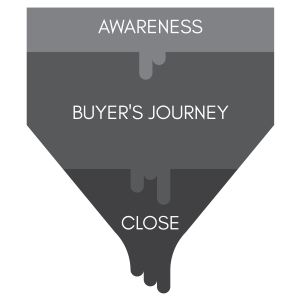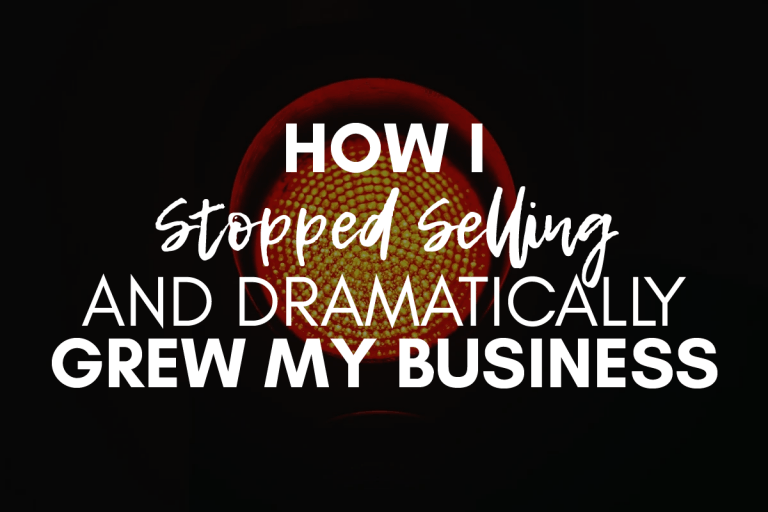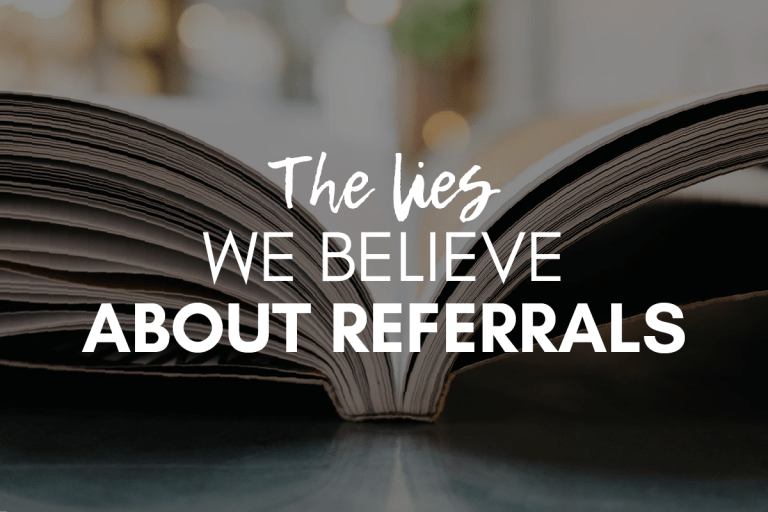Where Referrals Fit in Your Sales Strategy
What are your growth goals for the year?
And next year?
Do you know the exact plan you will follow to hit your target growth goals? Is that plan based on the results of what has worked before? And do you know what your options are if you have to tweak, adjust or pivot that plan?
On some level – as business owners – we have a general idea of what we want to accomplish. It is hard to get through the year without that general idea, even if it only exists in our head.
50 new clients.
Hit the $100,000 revenue mark.
$200,000 in revenue from a new service launched.
90% retention of existing clients.
$1M in total revenue.
Most of our goals focus on how much we want our business to grow…the number of new clients, revenue generated, etc.
Which means we need a client growth or sales strategy in place to hit our goals. A sales strategy – sometimes called a business development strategy – consists of the activities you do with action plans to fill the pipeline with prospects, and includes individual metrics for tracking success.
Those pipeline-filling activities include networking, cold calling, attending trade shows or conferences, direct mail, advertising, free presentations, referrals, one-on-one networking, publicity, joining leads groups, SEO, online leads, and more. (Not an exhaustive list of course.)
The general thinking is that business owners need a well-defined sales strategy made up of these different pipeline-filling activities. But ultimately what business owners need is an understanding of which activities work for them and then laser focus on the execution of those activities.
First, let’s look at what business owners shouldn’t do when it comes to their sales strategy. Second, we’ll look at what we should be doing by understanding the three parts of the sales strategy, including where referrals fit. Then we will assess your strategy.
SECTION 1: What Not To Do When Building a Sales Strategy
SECTION 2: Three Parts of a Functioning Sales Strategy
SECTION 3: Assessing Your Sales Strategy
SECTION 4: How to Move Forward
SECTION 1: WHAT NOT TO DO WHEN BUILDING A SALES STRATEGY
There are two traps that small business owners fall into when it comes to how they go about generating new clients. They either fall into the “spray and pray” method or the “singular focus, hope it works” method. Neither are the right method, but without a planned approach to how you will generate new clients, we become susceptible to falling into either one of them.
Spray and Pray
I can almost guess with complete accuracy that a business owner is operating under the “spray and pray” model when have this exchange…
THEM: “Hey, Stacey – here are all of the things we are doing to generate new clients, can I run them by you for your opinion? I’m curious if I should be doing more?”
ME: “What are the results you’re expecting in terms of prospects and clients from each of these?”
THEM: “Um…more clients.”
As a business coach with a focus on business growth, it is an exchange I am used to having. When they start listing off all of the activities (or things as they call them) they’re doing but haven’t taken the time to qualify them, I know they are just spraying and praying.
Meaning they are doing many different activities – usually more than 10 – which is effectively “spraying’ their effort, time and focus in many different directions and then “praying” one or some of them will pay off in filling the prospect pipeline. It is the haphazard method of their approach – not necessarily the number of activities that makes the spray and pray method ineffective.
They typically don’t have a process to identify what they should be doing – based on where they are likely to be exposed to their ideal client or people who know their ideal client. They just grabbed a bunch of activities, threw them up on the wall and is looking for what will actually stick. They aren’t measuring as they go. And then they haven’t taken time to assess what is working and what is not.
It is a trap because it makes us “feel” like we are busy, “feel” like we are doing the right things, “feel” like we are making progress.
But that feeling is just us hiding from acknowledging what we need to do or that we don’t know what to do. We need a laser targeted approach. Our approach may include a number of activities, but we can always answer why we are doing it and the outcome we are expecting.
Singular Focus, Hope It Works
The opposite of “spray and pray” is the singular focus approach…which means we focus in on one or two activities that we are willing to do and dig in hoping it works. Typically, this activity is something we really enjoy doing…hence why we focus in on it. Think about the person who attends just about every networking event they can every week. Or they produce tons and tons of blogs every week hoping people see them.
But we are still just “hoping” it works. Which is actually more dangerous than “spraying and praying” because at least we stand a chance that one or two of those activities will actually work while we are spraying and praying.
Just like the spray and pray method though, we are hiding from reality when we have a singular focus and hoping if we dig in enough, do it enough…that it will start to work.
But neither of these two methods are how you should be growing your business or filling your pipeline.
Let’s look at what you should be doing to have a focused approach that will work to help you increase your prospective client pipeline. Then I will walk you through an activity to assess what you’re currently doing so you can make informed decisions on what to do moving forward.
SECTION 2: THREE PLANS OF A FUNCTIONING SALES STRATEGY
The opposite of “spray and pray” and “singular focus” is becoming crystal clear on what your sales strategy needs. And to start, we need to unpack the 3 plans within a sales strategy. The reasons for the three plans is because your mindset is different when you approach the activities within each plan. By mindset, I mean the expected ROI (return on investment), time it takes for results, and even the approach you take or language you use within each plan.
The three plans are:
- the prospecting plan
- the marketing plan
- the referral plan
Most businesses start with one or maybe two of the plans – the prospecting plan and marketing plan – but rarely all three. I believe the reason for this is that referral generation is typically lumped in with prospecting or marketing which means we execute on it with the wrong mindset which dilutes its power.
Let’s dive in to understand what each plan is and why you need it.
Three Sales Plans
Prospecting Plan:
This plan is your high activity plan meaning you typically need a number of activities happening in concert with each other to produce any measurable results. The goal is to create short term success by finding those interested in your service and turning them into clients as quickly as possible.
I describe this plan as the plan you need if you “want to eat tomorrow.” For example – heading to the networking event where you hope to meet one or two prospects who will agree to coffee to discuss the possibility of working together.
This is the “pound the pavement or phones” type of plan that can produce results but take a huge commitment of activity in an ongoing and consistent manner. When starting out, you will deploy many activities in this plan – aim for 5 to 6 – and the goal is to decrease your reliance on these activities over time.
But remember, the activities themselves won’t produce results – it is how you plan to execute on the activity that matters most.
Activities in this plan include:
- Networking events
- Cold calling
- Joining a leads group
- Cold emailing
- 1-on-1 networking (coffee, lunch, etc.)
- Buying leads
- Attending trade shows or sponsoring a booth
Marketing Plan:
The marketing plan focus on establishing name recognition, building credibility and gaining awareness. Different companies deploy this plan in different ways.
Almost all have some kind of an online presence but the other activities you deploy with this plan will vary. A smaller budget may focus on a website and a few social media accounts and a more robust budget may include advertising (online, print) or earned media through publicity.
The goal is to build and maintain presence so if a potential new client is searching for a company like yours, they will find you. And remember, how you execute on this plan – the action plans for each activity – matters most.
Activities in this plan include:
- Website
- Advertising
- Public relations/PR
- Content marketing
- SEO (search engine optimization)
- Speaking engagements
- Social media marketing
Referral Plan:
The holy grail of new client generation is referrals…where new clients just show up in your inbox because someone connected them to you because you can help solve the problem. Now growing a sustainable and consistent referral plan doesn’t happen overnight and there are no silver bullets but following the right steps can produce consistent results.
The best part of a referral plan is it allows you to lessen your reliance on the prospecting plan and marketing plan to fill the pipeline with new prospective clients. My ultimate goal is to allow clients to eliminate as much activity from their prospecting plan as possible because they are experiencing consistent results with referrals.
Now, the referral plan is different from the prospecting and marketing plans because they referral plan is not made up of individual, stand alone “activities”. The referral plan is a holistic approach of a few specific strategies to follow and effectively execute on. For example, one of the basic referral strategies is for generating more referrals from existing referral sources and that process looks like this:
- Identify who are your referral sources (referral source = a person who refer you)
- Build relationships with referral sources correctly through a connection or touch point plan
- Use the right language – known as planting referral seeds – so you never ask for referrals
I wanted to provide an overview of the 3 sales strategy plans because in the next section we will assess what you are doing now and you may need to add or substitute some activities. You will be able to use the examples of activities in this section to help you build a better sales strategy.
SECTION 3: ASSESSING YOUR SALES STRATEGY
Before you jump into creating your customized version of your 3 plans along with the activities and strategies, we need to step back and assess how your current sales activities are performing, meaning how are you filling the pipeline with prospects.
An easy way to understand your sales pipeline is to consider an actual funnel with a top, middle and bottom. Now the steps inside the funnel may differ from one business to another but effectively all funnels work the same way. Your prospects come in the top through sources (which are the activities you do), then the prospect works its way through your buyer’s journey (the middle), and lands eventually in the bottom of the funnel – the close – hopefully by becoming a client.

It is crucial you understand where your prospective clients are coming from, meaning from which sources. Once we know the sources of your prospects we can then map the sources back to the activities to assess which are working and which are not. But first we need to assess current sources providing prospects, then judge that against the activities we are doing.
Assess First
The first step is to compile a list of the sales activities you are doing currently. List out the networking events you attend, the associations you belong to, if you have repeat clients, do you receive referrals, do you invest in advertising, attend trade shows, sponsor community or events?
To make this process easier, I have put together a PDF where you can gather all the information and move from this assessing step to making decisions based on the results.
Enter your name & email to download the Sales Strategy Activity
Remember, guessing isn’t the right strategy – we need the data to guide us. So please take a moment to complete the activity worksheet. Just enter your name and email above to have the PDF emailed to your inbox so you can safely download it and start using it.
On page 2 of the worksheet, put all the activities in the wheel according to the step. Instructions are also included in the worksheet on page 2.
The second step is to list out your current clients and where they came from. That will get you started but not necessarily provide you with a complete list. You will also want to look back at your previous clients and prospects that didn’t become clients as well to list out where they came from as well. (If you are newer in business, prospects – not yet clients – might be all you have.) So, you would write down Client Susie who you met at a networking event and Prospect Tom who saw your advertisement and called but did not become a client.
Now – after completing the first two steps – you have your brain dump of your sales activities and the list of where your clients and prospects came from.
Which brings us to the third step. We need to compare the sources of your clients and prospects with the list of your current sales activities to determine the results of your activities (which is working, which is not).
Judge Second
Again, I recommend you enter your name and email above to download our free copy of this exercise so you follow along step-by-step and keep all of your work together.
The power of the Sales Strategy Activity is in the calculations… once you know which activities you are doing and have an idea of where your prospects and client are coming from, you can them complete the chart to determine your closing ratio by activity. This tells you what is successful and what it not.
If the term “closing ratio” is new to you, your closing ratio is the number of new clients divided by the number of prospects by activity. For example, if I received 30 referrals (referred prospects) and closed 25 of them into clients, my closing ratio for my referral activity would be 83%.
Here’s some points to consider:
#1. After you determine the closing ratio for each activity, then you can capture your top 3 sales generating activities.
#2. But also make note of your bottom 3.
This is how we decide which of our activities need more attention, or which activity we need to learn to do better, but we’ll also see which ones we should probably drop and – of course – which ones to keep doing because they are working.
Once you complete the entire worksheet, your results will produce one of three outcomes. They are:
-Fantastic
-Not Horrible, But Not Great Either
-Houston, We Have a Problem
If your results produce either “Houston, We Have a Problem” or “Not Horrible, But Not Great Either” then you should consider how you are attempting to fill your prospect funnel or pipeline. You need to assess if you are spending time in the right areas – if the sources you are working are actually working for you. If there is a disconnect between the activities you are doing to generate clients and the results of where your clients are coming from…then you need to get to work fixing that problem. The good news is this is solvable.
Quick note – if you can’t complete the activity because you don’t know where your prospects and clients are coming from, then you lack tracking which is something you can start doing today. You need to start tracking because tracking provides clarity on how your prospect pipeline is filled and provides additional valuable data. The best data to track – if you want to keep it simple – is the date the prospect became a prospect, the prospect’s name and contact info, plus the source of where the prospect came from.
Before You Ditch a Source
After completing the Sales Strategy Activity, you will know – based on data – what is working and what’s not. If you decide to eliminate an activity from any of your three sales plans – because it’s performing poorly – it’s important to be clear on the reason it is not performing well. It is either because you aren’t putting enough effort in, you might need to improve your process and tactics with the activity, or because you have limited capacity to make the activity successful. Truth is, not all sales activities we attempt will work.
Here is a word of caution regarding your referral plan. If after completing the Sales Strategy Activity you determine your referral plan is not working as you would prefer, whatever you do, do NOT eliminate it. You need it but you need to know how to execute on it correctly so it works for you and produces the results you want. The ultimate goal is to increase the success of your referral plan so you can decrease your reliance on the other two plans – prospecting and marketing – and all of the activities that make up those two plans.
I find following my referral plan to be one of the most enjoyable parts of my sales strategy because it allows me to generate referrals naturally… without asking, without manipulation and leverages my time.
Keep in mind, when you don’t have a plan in place to specifically grow referrals, they don’t grow.
To learn how to generate referrals and build your referral plan, click here.
Categorize Your Activities
One final step you can do is to be clear on which category your activities fall into is to label each source/activity as either prospecting, marketing or referral. I encourage you to label them so you know how many activities you have per plan and have them ranked by viability (based on the closing ratio process mentioned above).
The other reason to group them by the three sales plans is because your mindset and approach is different when executing on the activities within each of the plan, so you can be clear on the tactics, methods and language.
SECTION 4: MOVING FORWARD
As you look to move forward with new data about how your sales strategy is performing, it’s time now to make decisions.
What are your top performing activities or sources? With this knowledge you can map out your action plan to leverage the sources working and improve those that are not working that you want to keep.
Which sources are you going to cut?
Are there others you need to add that you aren’t currently doing but you believe will work? (Like referrals! Just sayin’.)
Do you need to consider which sources you want to improve or add that may require skill or process improvement? Do you need to consider training or accessing other resources to help you with how to perform a source better?
Knowledge is power – as you make a strong, accurate assessment of how the different sources within your sales strategy are working and other sources you want to add.
If I can assist you with your referral generation, I’d love too. I offer different training programs for all learning types and budgets. From online programs to learn a single strategy (like more referrals from existing referral sources) or my group coaching experience where you learn all of the referral strategies plus have 1:1 access with me plus weekly group coaching sessions to assist you as you need them.
Check out our programs using the “Programs” tab at the top of the webpage or visit here!
And if you arrived here at the end of the article without downloading the Sales Strategy Activity, I encourage you to do so now! Download it and complete it.
Just enter your name & email to download the Sales Strategy Activity now!
I look forward to hearing about the changes you make to your overall sales strategy so you can have the success you deserve!
Good luck!








Hello, is the Sales Strategy Activity resource still available? The link doesn’t seem clickable – I’d love a copy.
Thank you.
Hey Matt! Yes, we will get this link corrected. It may be the final link to correct from our website re-design and hosting change. I will also email you the link so you don’t have to go searching for it when it is ready! Thanks!! – Stacey
Excellent information Stacey. My entire team has read your book. Looking to review and dive into next week on a team call. I personally have been enjoying your website, Facebook page, and podcast. The beginning of a new year is a great time for review and reflection. I look forward implementing your strategies. This year my goal is to be more intentional in and around the referral source. Having a plan of action in place that is focused on the referral experience, showing gratitude for the trust the referral source has placed within me.
I look forward becoming a Referral Ninja Master.
Thanks so very much.
Thanks Craig. I love your intentionality and resolve to become a Referral Ninja Master!